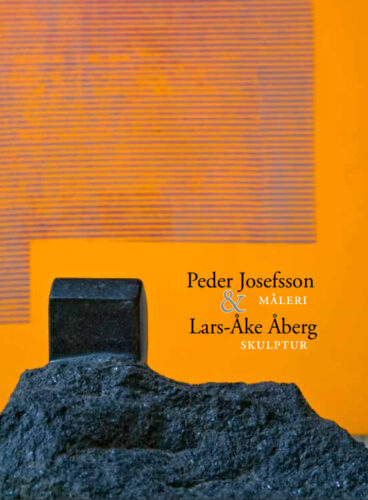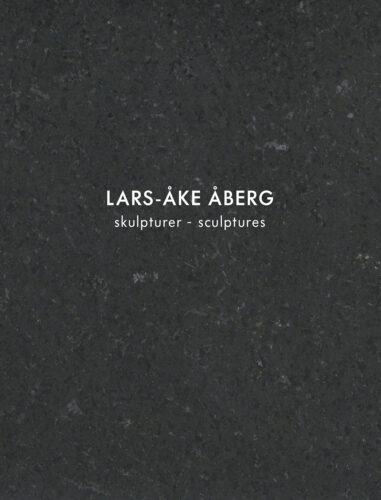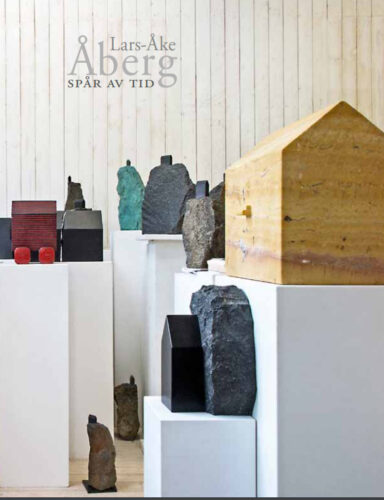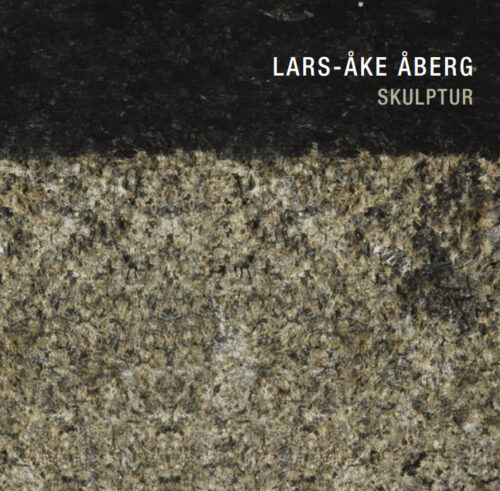PUBLICATION
Catalogues
Extracts from publications and reviews

Konsthallen Hishult
2011

Skulpturer – sculptures
Text Rolf Haglund
2011
Extracts from publications and reviews
”…Lars-Åke Åbergs förälskelse i stenen går inte att ta miste på – inte heller hans förkärlek för huset som skulptural form och även som en djupt innehållsrik symbol. Hans första husskulpturer var slutna i formen, oftast utan vare sig dörrar eller fönster. Men undan för undan bröts slutenheten upp; det dök upp en utbuktning i en vägg, några hus ställdes på rullar, en del fick till och med fönster, om än minimala. Och så ser hans hus i princip ut fortfarande … Ändå har det hänt mycket sedan de där första husen, konstaterar jag nu i Flaménska galleriet och förundras över att en så enkel form kan varieras på så många sätt. Något av husen har spruckit på mitten, ett annat balanserar oroväckande på den yttersta utposten av en starkt eroderad bergstopp – associationerna hopar sig. Men hela tiden är det stenens egenskaper som utgör grunden i skulpturerna, företrädesvis den svarta diabasen med sina rika skiftningar i olika jordtoner.Samtidigt som utställningen i viss mån är retrospektiv pekar den också framåt med många intressanta exempel på ett uppenbarligen ihärdigt experimenterande. Som installationen Circular Living där en välplanerad spegeleffekt får gruppen av små huskroppar i vit marmor och alabaster att likna en drömd idealstad. Eller en överdimensionerad äppelskrutt i ljuvligt honungsfärgad onyx-marmor som samsas fint med två lika uppförstorade rocka-äggkapslar i svartfärgad brons.
En mer fri och lätt lekfull ton finner jag också i det inre rummet där Lars-Åke inte bara spinner vidare på spegeleffekten utan också vitsigt har fyllt sitt ”Fröhus” med hopsamlade maskrosbollar och ytterst verklighetsnära illustrerar begreppet ”Sten i glashus”.”
Review in Borås Tidning 2020 by Inger Landström
”…Bort från finrummet. I Borås möter internationella storheter som franske Xavier Veilhan och spanske Jaume Plensa verk från tidigare biennaler. Det skapar en symbolisk tidsmässig oordning – men först med Lars-Åke Åbergs ”HUS 261” problematiserar biennalen sin egen finrumshistorik…Var börjar och slutar någonting? När jag söker mig förbi ödetomter och över en huvudled för att leta efter ”HUS 261″ i Norrby, en stadsdel i miljonprogramsanda bakom Textile Fashion Center, känns det som om inte bara centret, utan hela staden vänder ryggen till…Men även här finns en skulpturtradition att ta till vara, vilket Lars-Åke Åberg också lyckas med. Abstrakta kompositioner och lekvänliga skulpturer i ett område konstälskare sällan vallfärdar till. Med placeringen i Norrby börjar skulpturbiennalen problematisera sin egen historik av att röra sig inne i stadens finrum. En sorts självkritisk hållning som är nödvändig om biennalen skall hållas levande.”
Review in Svenska Dagbladet 2014 by Håkan Nilsson
”…Lars-Åke Åberg´s sculptures make it possible to perceive the strong symbolic value of the house. The house appears obviously as form, and possibly also as symbol, in his artistic oeuvres. The sculptures consist of a house and a block of stone – the crude local type of rock, or the well polished fine stone from some exotic locaction. The house is always of a similar shape: square with a pitched roof, completely free of details such as windows, doors frames and verandah.
If it rally is a house at all. Maybe it is just a question of a shape similar to a house. That question is left open. The impact can seem tranquil and contemplative, while it is also possible to perceive a sense of uneasiness. Exaggerated size distorsions, playing with forces and the material´s own effect are all parts of Lars-Åke Åbergs palette.”
From the catalogue ”Borås International Sculpture Biennal 2014”, text Karolina Pahlén
”…At root, Lars-Åke Åberg is a painter but he is also an artist who has been turning more and more to sculpture and the heaviest of all materials – stone. For many years, Åberg has been creating house-like sculptures in a number of different types of stone: diabase, marble, alabaster, black labrador, limestone and granite. Åbergs early houses are severe and without detail – perhaps the archetypal house?
The sculpture called House 18 (2007) is cut out of blocks of alabaster and marble. The house rests silently on two rods and, despite the heavy material, there is a lightness in the sculpture, something that, alongside its position in the church, emphasises the sacred imagery of the work.”
From the catalogue ”Borås International Sculpture Biennal 2012”, text Anna Nero
”…Out of marble, limestone, granite, travertine and diabase Lars-Åke Åbergs houses are liberated. They are simple fairly small rectangular houses with a gable roof. Some with the suggestion of a window. Some with a slightly kitschy micro diamond high up on the gable. Some – quite a lot – are crowned with a steep cliff (all carved in a single piece), and bring with them echoes of medieval impregnable castles and the Greek Ortodox eagle-nest monasteries. In all their apparent simplicity the sculptures provide an ample measure of aesthetics that is mainly contained in the balanced fluctuations between rough cut and polished surfaces. Åberg has cast one of the ”cliff houses” in bronze and then patinated it green. This whets the appetite and represents the highlight of an exhibition where Josefssons paintings, Åbergs sculptures and the architecture of the exhibition hall merge into an aesthetically enjoyable and artistically enriching overall experience…”
Review in Hallands Nyheter and Borås Tidning 2011 by Britte Montigny
”…Åberg´s works are open to every interpretation, tranquil and yet alarming, classical in character, while the stone material itself speaks of the beauty and stability we need. His works measure the space of Man in the moment and in the present age, let us experience a feeling of vertigo and transform chaos into eternal order.”
From the catalogue ”Lars-Åke Åberg – Sculptures”, text Rolf Haglund 2011
”… In rare cases, two artists not only enrich one another, but together provide insights that partially provide new perspectives, not only for the observer, but for the artists themselves . This is the case at Rydal Museum…
För nåt sånt behövs en tredje faktor, en katalysator, som förmår oss att se och associera på helt nytt sätt. En sån finns också med i Rydal när mästerhängarenBengt-Göran Johansson helt på egen hand fått Peder Josefssons minimalistiska måleri och Lars-Åke Åbergs husskulpturer att samverka inbördes och med den luftiga lokalen till något säreget och fördjupande.
Den i Skene uppväxte Josefsson och den i Dalsjöfors bosatte Åberg har också tidigare ställt ut tillsammans. Detta är tredje gången, och enligt dem båda den vackraste… Äntligen får vi se Åbergs konst i hela sin vidd med lika subtila som fantasiberikande upplevelser när husformerna med ens ej är trygghetssymboler utan gestaltar otryggheten och vansinnet i vår värld – och ändå tycks le i mjugg. På smått magiskt vis ser vi hur han förmår grovhet och tyngd att samverka med det blankpolerade och linjerena. Verkens utsatthet understryks av att den skarpsynte i två av husen kan upptäcka en inlagd alldeles äkta diamant och i ett tredje en dito rubin… Meaningfulness brings both artists´work together to create something completely new, so that one would like to preserve the exhibition for the future, maybe in video form. Here, the exhibition´s format itself has become a unique and meaningful part of the experience of art.”
Review in Borås Tidning 2009 by Rolf Haglund
”…What is shown is nature’s ABC, notes of visual stimuli paired with emotional experiences; a concretization and visualization of ideas. A conversation into aesthetically pleasing images, which puts the viewer´s imagination in motion. You meet the artist and are drawn into events that are both lyrical and dramatic.”
Review in Skaraborgs Läns Allehanda 1993 by Sigvard Sjöqvist

